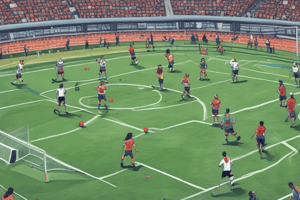Podcast
Questions and Answers
What is the main responsibility of a goalkeeper?
What is the main responsibility of a goalkeeper?
- Support the midfielders
- Prevent the opposing team from scoring (correct)
- Win headers
- Score goals
What is the role of a Central Midfielder?
What is the role of a Central Midfielder?
- Score goals
- Control the tempo and distribute the ball (correct)
- Support the defense
- Defend the goal
What is a type of stadium that hosts various events, including concerts and athletics meets?
What is a type of stadium that hosts various events, including concerts and athletics meets?
- Traditional stadium
- State-of-the-art stadium
- Soccer-specific stadium
- Multi-purpose stadium (correct)
What is a common feature of a stadium's pitch?
What is a common feature of a stadium's pitch?
What is the role of a Target Man?
What is the role of a Target Man?
What is a common feature of State-of-the-art stadiums?
What is a common feature of State-of-the-art stadiums?
What is the role of a Captain?
What is the role of a Captain?
What is the typical length of a stadium's pitch?
What is the typical length of a stadium's pitch?
What is a type of player that creates scoring opportunities with vision and passing range?
What is a type of player that creates scoring opportunities with vision and passing range?
What is a typical feature of Traditional stadiums?
What is a typical feature of Traditional stadiums?
Flashcards are hidden until you start studying
Study Notes
Players
Positions
- Goalkeeper (GK): responsible for preventing the opposing team from scoring
- Defenders (DF): help the goalkeeper by defending the goal and blocking opponents' shots
- Center-back (CB): defends the goal and wins headers
- Full-back (FB): defends the wings and supports the midfield
- Midfielders (MF): connect the defense and offense, maintaining possession and creating scoring opportunities
- Central midfielder (CM): controls the tempo and distributes the ball
- Winger (WG): supports the attack and provides width
- Forwards (FW): score goals and create scoring opportunities
- Striker (ST): scores goals and holds up the ball
- Attacking midfielder (AM): creates scoring opportunities and scores goals
Roles and Responsibilities
- Captain: leads the team, communicates with the coach, and makes tactical decisions
- Playmaker: creates scoring opportunities with vision and passing range
- Target man: wins headers and holds up the ball to bring others into play
Stadiums
Types of Stadiums
- Traditional stadiums: built for football, with a focus on atmosphere and seating capacity
- Multi-purpose stadiums: host various events, including concerts and athletics meets
- State-of-the-art stadiums: feature advanced technology, comfort, and amenities
Stadium Features
- Seating capacity: varies from 10,000 to over 100,000
- Pitch size: typically 100-110 meters long and 64-75 meters wide
- Turf: natural grass or artificial turf, with some stadiums having hybrid surfaces
- Roof and lighting: some stadiums have retractable roofs and advanced lighting systems
- Amenities: include VIP suites, restaurants, and amenities for players and spectators
Players
Positions
- A goalkeeper's primary responsibility is to prevent the opposing team from scoring.
- Defenders help the goalkeeper by defending the goal and blocking opponents' shots.
- Center-backs are responsible for defending the goal and winning headers.
- Full-backs defend the wings and support the midfield.
- Midfielders connect the defense and offense, maintaining possession and creating scoring opportunities.
- Central midfielders control the tempo and distribute the ball.
- Wingers support the attack and provide width.
- Forwards are responsible for scoring goals and creating scoring opportunities.
- Strikers score goals and hold up the ball.
- Attacking midfielders create scoring opportunities and score goals.
Roles and Responsibilities
- The captain leads the team, communicates with the coach, and makes tactical decisions.
- A playmaker creates scoring opportunities with vision and passing range.
- A target man wins headers and holds up the ball to bring others into play.
Stadiums
Types of Stadiums
- Traditional stadiums are built for football, focusing on atmosphere and seating capacity.
- Multi-purpose stadiums host various events, including concerts and athletics meets.
- State-of-the-art stadiums feature advanced technology, comfort, and amenities.
Stadium Features
- Seating capacity varies from 10,000 to over 100,000.
- Pitch size is typically 100-110 meters long and 64-75 meters wide.
- Turf can be natural grass, artificial turf, or a hybrid surface.
- Some stadiums have retractable roofs and advanced lighting systems.
- Amenities include VIP suites, restaurants, and facilities for players and spectators.
Studying That Suits You
Use AI to generate personalized quizzes and flashcards to suit your learning preferences.




